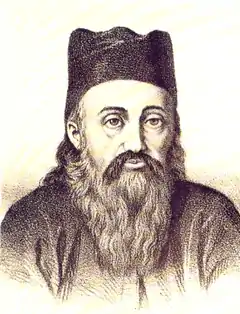Balanos Vasilopoulos
Balanos Vasilopoulos (Greek: Μπαλάνος Βασιλόπουλος, 1694–1760) was a Greek scholar, cleric and author. He made a significant contribution in the growth of Greek Enlightenment during the Ottoman occupation of the Greek world.
Kosmas Balanos | |
|---|---|
 | |
| Born | 1694 |
| Died | 1760 |
| Scientific career | |
| Fields | Mathematician |
| Institutions | Gouma (or Balanaia) School |
Life
Balanos was born in Ioannina, major center of the Greek Enlightenment movement during that time.[1] He was a student of Methodios Anthrakites director of the local Gouma (later Balaneios) school. As a teacher he initially became director of the school Epifaneios Igoumenos (1719–1734) and then the Gouma. Both schools were the most prestigious in Ioannina.
In the Greek language question, he supported the conservative party and the teaching of classical Greek in education. Balanos was accused for this position by Eugenios Voulgaris, a progressive supporter of Demotic.[2] In ca. 1760 his son Kosmas Balanos succeeded him as schoolmaster of the Gouma School.[3]
Work
He expanded and reprinted the work of his teacher Methodios Anthrakites The Way of Mathematics (Greek: Οδός Μαθηματική, 1749).[4] This was the first handbook in the field of mathematics published in Greek during the Ottoman occupation.[5] He also wrote the following, and various other books of less significance:
- Έκθεσις ακριβεστάτη της αριθμητικής (Precise Exposition of Arithmetic), Venice, 1803
- Ερμηνεία εις τους αφορισμούς του Ιπποκράτους (Interpretation of the Aphorisms of Hippocrates)
Balanos claimed to have solved the problem of doubling the cube, i.e. finding the cube root of 2 using ruler and compasses. He published this in Venice in 1756, and attempted to gain international recognition for his solution from the community of mathematicians, and in particular Leonhard Euler and the members of the Saint Petersburg Academy of Sciences. His son Kosmas Balanos rejected the solution in a work published in 1816 after his own death, Αντιπελάργησις (Antipelargisis, Against the Stork). The problem was later proved to be impossible.[6][7]
References
- Balanos Vasilopoulos. Πανδέκτης, Νεοελληνική Εικονιστική Προσωπογραφία.
- Dēmaras, Kōnstantinos (1972), A history of modern Greek literature, SUNY Press, p. 136, ISBN 978-0-87395-071-8
- Μπαλάνος Κοσμάς 1731, Ιωάννινα – 1807/8, Ιωάννινα Archived 2012-04-02 at the Wayback Machine Ελληνομνήμων. University of Athens database.
- Kostantaras, Dean J. (2006), Infamy and revolt: the rise of the national problem in early modern Greek thought, East European Monographs, p. 164, ISBN 978-0-88033-581-2
- Sakellariou, M. V. (1997), Epirus, 4000 years of Greek history and civilization, Ekdotike Athenon, p. 268, ISBN 978-960-213-371-2
- Phili, Christine. "Greek mathematical publications in Vienna in the 18th–19th centuries" (PDF). Mathematics in the Austrian-Hungarian Empire. Proceedings of a Symposium Held in Budapest on August 1, 2009 During the XXIII ICHST.: 137–148.
- Lambrou, Michael. “An attempt to duplicate the cube during Ottoman times, and the text of ‘Antipelargisis’”. (Euclides, 11 (1994) 41-67). Cited in his Curriculum Vitae Archived 2012-03-26 at the Wayback Machine, retrieved 25 June 2011.